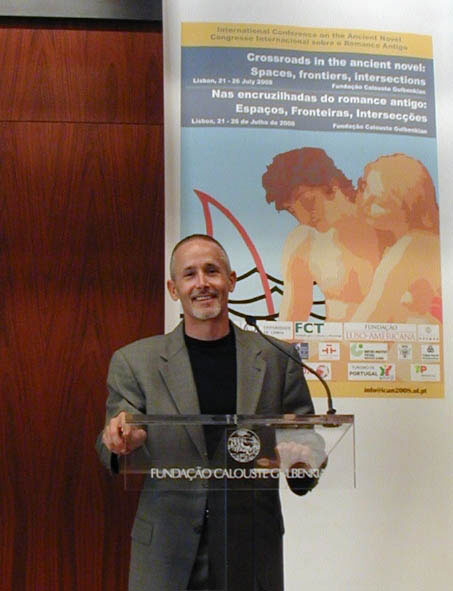
quarta-feira, julho 30, 2008
History as Fiction, Fiction as History: Fictive Inspirations for a Modern Historical Novelist of the Ancient World

segunda-feira, julho 28, 2008
Gordianus's comeback
"I thought you were dead", says Calpurnia, Caesar's wife, when she meets Gordianus at the very beginning of Saylor's latest novel from the Roma sub Rosa series, The Triumph of Caesar. Many fans, too, thought Gordianus was dead in the troubled, crocodiled waters of the Nile. He didn't, and he's back with his family, safe and sound, dis gratias. And his projects for a quiet, peaceful retirement are once again blown apart. Calpurnia has been having strange dreams about Caesar's fate, supported by her etruscan soothsayer predictions, and Gordianus is to find the truth about it. But what appeared to be no more than irrational turns out to be a case of murder, when Gordianus learns his dear friend Hieronymus was murdered, trying to find Caesar's enemies. More than saving Caesar's life, Gordianus wants to find who murdered his massilian friend. Or so he says at the begining. The Triumph of Caesar is, again, a wisely made depiction of the end of the roman Republic, with it's social, cultural and political aspects. There we meet again a cold and clever Cleopatra, an ambitious Marc Antony, a ridiculous Cicero, and, though briefly, an icy cold Octavius, one of the best portraits of the future Augustus I've ever read in fiction.
Steven Saylor was in Lisbon, to the ICAN congress (22-26 july), and also to present the portuguese translation of The Triumph of Caesar: "O Triunfo de César". Saylor met some of his fans in a session in Bertrand-Chiado library. The turnout was excellent, there were dozens of fans, who listened to the author's interesting and witty talk about his books, all translated to portuguese by Maria José Figueiredo, also present. The fans made many questions, and the talk was excellent. Now we're all looking forward to Roma's sequel, that would lead us from where the first book left us, at Augustus time, to Constantin.
More photos here.
sábado, julho 26, 2008
15 anos de Thíasos
quinta-feira, julho 24, 2008
Hadrian: Empire and Conflict
«24 July - 26 October 2008 Reading Room £12, concessions available
The Roman Emperor Hadrian (117 to 138AD) is best known for his passion for Greek culture, interest in architecture, his love for Antinous, and of course the eponymous wall he built between England and Scotland, then Caledonia. This exhibition, supported by BP, will look beyond this established image and offer new perspectives on his life and legacy, exploring the sharp contradictions of his personality and his role as a ruthless military commander. Incorporating recent scholarship and the latest spectacular archaeological discoveries, the exhibition will feature over 180 objects from 28 lenders from Italy to Georgia, from Israel to Newcastle. Loans of dramatic sculpture, exquisite bronzes and architectural fragments will be brought together and displayed for the first time in the UK, alongside famous objects from the Museum’s own collection such as the iconic bronze head of Hadrian and the Vindolanda tablets. This exhibition will be held in the Round Reading Room, often compared to one of Hadrian’s architectural masterpieces, the Pantheon in Rome.»
Mais aqui.
Um vídeo promocional poder ser visto aqui.
Call for papers
LATIN AND VERNACULAR IN RENAISSANCE IBERIA IV:
THE INFLUENCE OF CHRISTIAN LATIN LITERATURE
Following the success of Latin and Vernacular in Renaissance Iberia I -III (1998-2007), we propose a fourth conference to explore one particular aspect of this field, to be held at the University of Cork (Republic of Ireland) on 15-16 April 2009.
Up to twelve papers of twenty minutes, in English, Spanish or French, are invited on the reception and influence on the literary cultures of the Iberian Peninsula of Latin texts of whatever date written by Christian authors. The period of reception will be 1400 to 1700.
Offers of papers should be sent to the organisers by 15 January 2009.
The organisers are:
| Dr Barry Taylor Early Printed Collections The British Library 96 Euston Road London NW1 2DB E-mail: barry.taylor@bl.uk
| Dr Alejandro Coroleu Dept. of Spanish, Portuguese and Latin American Studies University of Nottingham Nottingham NG7 2RD E-mail: alejandro.coroleu@nottingham.ac.uk |
Encontro com o autor Steven Saylor
sábado, julho 19, 2008
Instituições da Língua Arábica

Um dos aspectos mais interessantes destas Instituições é a separação que fazem entre "árabes" e "mouros", que vai ao pormenor - importantíssimo para nós, "andaluzes" - de distinguir a escrita "levantina" (isto é: a escrita padrão) da "africana", argumentando que a tal obrigava o intenso comércio com o Magrebe, bem como os manuscritos dos tempos árabes na Península, sobretudo das épocas dos impérios berberes (Almorávidas e Almôadas). Além das recorrentes explicações, o autor agrega mesmo um quadro comparativo das formas manuscritas "levantinas" e "africanas".
Apesar de algumas limitações, devidas mais à linguagem da época e sobretudo à terminologia, que por vezes é completamente opaca, parece-me um documento muito importante na História dos estudos árabes em Portugal.
Deixo um cheirinho das considerações iniciais, que bem se poderiam aplicar ao Latim:
A Utilidade da Lingua Arabiga, que n'outro tempo foi muito conhecida neste Reyno, e que agora pelas luzes do nosso Ministerio se acha felizmente promovida, he o que me obrigou a composição desta Arte, que me resolvi dar á luz pública. Eu não gastaria o meu tempo com este trabalho, se me deixasse preoccupar dos gritos da ignorancia, que com escandalo da razão se atreve a dizer, que esta Lingua he inutil. Bastará conhecer o excesso, com que ella se distingue entre as outras, para se fazer estimavel por todos aquelles, que aspiram a conseguir conhecimentos vastos, e uteis.
quinta-feira, julho 17, 2008
Ancient Times Today
A CeDeCe (Companhia de Dança Contemporânea) e o Ballet do Teatro Nacional da Croácia apresentam, dia 18 de Julho no Mosteiro de Alcobaça, e 19 e 20 no Teatro Nacional D. Maria II, "Ancient Times Today", um espectáculo que revisita dois marcos da cultura mediterrânica: Penélope e o Cântico dos Cânticos.
quarta-feira, julho 16, 2008
Latim para almoço
O director de uma editora de Kent (Inglaterra), ex-professor, decidiu ensinar latim aos seus funcionários durante a hora de almoço. Ver notícia na BBC.
quinta-feira, julho 10, 2008
Loba Capitolina mais nova do que se pensava

sábado, julho 05, 2008
Problemas de alguns diplomas medievais
Conferência
Problemas de alguns diplomas medievais

Universidade de Santiago de Compostela
FLUL | Sala D. Pedro V | 14 de Julho de 2008 – 11:30


sexta-feira, julho 04, 2008
Nova tradução dos Annales de Tácito
Saiu há semanas a nova tradução dos Annales de Tácito. Trata-se de uma obra escrita na segunda década do século II da nossa era e que conta a história de Roma a partir da morte de Augusto, seu primeiro imperador. Depois de Augusto, governaram em Roma Tibério, Calígula, Cláudio, e Nero. Infelizmente, perderam-se os livros que Tácito escreveu sobre Calígula e os que contam a história de Tibério, Cláudio, e Nero, encontram-se fragmentados. No entanto, há centenas de páginas para descobrir. Quem não sabe latim (e mesmo quem sabe) pode agora, com a tradução de J. C. Yardley, ter acesso ao texto de Tácito através de uma língua moderna.
A tradução, incluída na colecção Oxford World’s Classics, é das melhores já feitas a partir do latim. Anulando as dificuldades de interpretação e sintaxe que a tradução de A. J. Woodman copiava de Tácito, na versão de Yardley pode encontrar-se um inglês vivo e corrente, sem deixar de ser fiel ao original.
A edição é enriquecida com uma introdução e notas de Anthony A. Barrett, bibliografia, cronologia, mapa, glossários, e um índice onomástico.
Tacitus, The Annals: The Reigns of Tiberius, Claudius, and Nero, trad. J. C. Yardley («Oxford World's Classics», Oxford: Oxford University Press, 2008).
quinta-feira, julho 03, 2008
Doubt over date for Brit invasion
Julius Caesar's invasion of Britain in 55BC could not have occurred on the dates stated in most history books, a team of astronomers has claimed.
The traditional view is that Caesar landed in Britain on 26-27 August, but researchers from Texas State University say this cannot be right.
Dr Donald Olson, an expert on tides, says that the English Channel was flowing the wrong way on these dates.
An invasion of the south coast at Deal on August 22-23 is favoured instead.
The claims appear in the latest issue of Sky & Telescope magazine.
Caesar came to Britain with 100 warships and two legions comprising 10,000 men. But as he approached Dover's white cliffs, spear-wielding Celtic warriors lined up along the ridge, prompting the Roman leader to look for a better landing spot.
He ordered his fleet to move along the coast, and after travelling about seven miles they came to "an open and flat shore".
What has been a matter of some debate is whether Caesar sailed left or right and when exactly his armada landed.Astronomical solutionCaesar mentioned strong tides, a full Moon and an ocean current. The astronomers Edmund Halley and George Airy previously used this information to try to solve the problem. But they disagreed with each other's conclusions.
Dr Olson identified August 2007 as a rare opportunity to investigate the question of when Caesar landed.
During this month, complex tidal factors involving the Moon and Sun would unfold in a near-perfect replay of those in August of 55 BC. So the researchers conducted an expedition to the south coast of England in order to investigate their idea.
On the day which corresponded closely to the traditional date for the invasion, Dr Olson carried out a basic experiment - dropping an apple into the sea off Deal pier at roughly the time of afternoon when Caesar described the fleet moving.
The apple floated south-west towards Dover, suggesting that the Roman fleet could not have travelled up to Deal from Dover on that day.
"The English Channel was flowing the wrong way," said Dr Olson.
Caesar's account led the researchers to focus on a possible invasion date a few days earlier.
On the day corresponding to the revised date of 22-23 August, the team chartered a sightseeing boat and took GPS readings to determine how the boat was drifting.
They found the boat was floating north-east towards Deal.
The Texas team's revised date gives Caesar the ocean current he needed to manoeuvre right, proceed seven miles, and land with a falling tide near present-day Deal.
This is the beach preferred by most historians but rejected by tide experts in the past. A modified reading of Caesar's reference to the "night of a full Moon" also leads to the August 22-23 date, Dr Olson claimed.
"The scientists were right about the tidal streams and so were the historians about the landing site," he explained.





